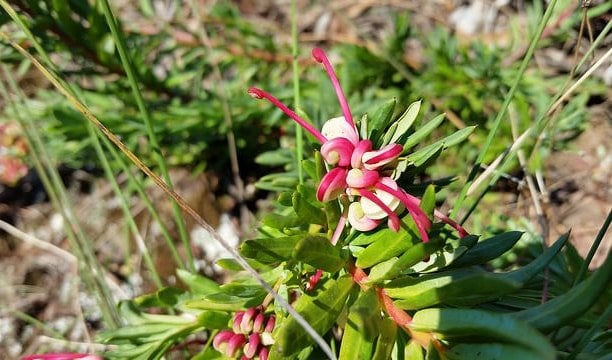Don’t forget about Australia’s threatened plants

BACK IN 2002, Australia was categorised along with 17 other countries as ‘megadiverse’, meaning that, together, they contain over 70 per cent of the world’s species. We have deserts, wetlands, rainforests – tropical and temperate – alpine regions and shrublands, all containing unique, highly adaptive flora, with many species unchanged over millions of years.
After almost two centuries of European settlement the biodiversity of Australia, however, has faced a number of challenges – most importantly huge losses of habitat resulting in fragmented ecosystems and a lack of connectivity, and the introduction of invasive species such as rabbits and goats, which eat or trample our flora.
According to Seedbank Manager at the Australian PlantBank, Peter Cuneo, around 37 species of plant have gone extinct in this time, meaning that, compared to other countries, we’d be considered “middle of the pack” when it comes to our plant extinction rate, just behind the United States, south-east Asia, South America and Madagascar, he says.
The changing climate means that “the native flora that existed in an area prior to European settlement is not always the most appropriate or possible to re-establish in our projects today,” explains Greening Australia’s National Programs and Science Director Todd Berkinshaw. This means organisations like Greening Australia need to think about what Australia’s future climate and landscapes will look like in 50 years’ time.
“The biggest challenge we face as a national organisation is the sheer scale of the task ahead of us and ensuring we have the financial, physical and intellectual resources available to respond at a scale that will have real impact in the time scale required,” Todd says.
That Australia’s threatened plant species are not at the forefront of conversations about the country’s current extinction crisis is concerning, says Peter. “Our charismatic fauna always enjoys a much higher public profile, and attracts a higher level of support than plant conservation projects,” he pointed out, adding that there is a perception that the bush will “always be there”.
“We have to consistently push the message, ‘no plants equals no life’. Plants are the backbone of all life on earth, they support oxygen and water production, they stabilise the climate, provide food, medicine and shelter. Without our unique flora there would be no food or habitat for the fauna.”

“Collecting seeds and other plant material to be stored in our seedvault or cryopreservation tanks is essential in case they disappear from the wild forever,” says Peter Cuneo. (Image credit: John Gollings)
A race against time
New species of plant are constantly being discovered and rediscovered. Just last year, 1730 new species of plant were discovered worldwide. Peter says that, at the Royal Botanic Garden Sydney, botanists and ecologists are consistently finding new species, suggesting we hardly have a full picture of Australia’s own diverse flora.
Modern genomic technology is helping scientists describe these plants and track their evolutionary history at a pace never seen before. And according to Peter, this is key to the successful protection and management of these species. “Many species are disappearing before they have been scientifically documented. That is why the work of our scientists both in the field and in the labs is so crucial,” he says.
One of the most threatened groups of plants are orchids because of their dependence on mycorrhizal fungi and pollinators. Currently, there are 76 native terrestrial orchid species listed as threatened in NSW alone.
Even more plants, particularly those from Australia’s alpine regions, will be impacted by climate change. Further study is currently being conducted to better understand this impact.
“The 1.43 million plant specimens kept at the National Herbarium of NSW are used to study the classification, ecology and evolution of plants, providing a record of plant distributions through time and space. Herbarium specimens are frequently used and provide some of the best evidence for large-scale responses to recent climate change,” Peter says.

Last year, the wee jasper grevillea — a critically endangered member of the Proteaceae family, flowered in the Burrinjuck Nature Reserve for the first time in two decades. (Image credit: L. Lindsay/ Environment and Heritage NSW)
Nature laws
At present, 1335 plant species are listed as threatened under the Environment Protection and Biodiversity Conservation Act 1999 (EPBC Act), and 11 other species are having their status assessed by the Threatened Species Scientific Committee (TSSC) – an independent body of conservation scientists.
According to Evan Quartermain, the head of programs at the Humane Society International (HSI) – an organisation that works to secure legislative protection for habitat – this backlog isn’t the end of the problem. “It’s highly likely there are dozens more plant species requiring protection that don’t have it.”
HSI has been responsible for nominating close to 40 per cent of the threatened ecosystems currently listed nationally. “These ‘Threatened Ecological Communities’ provide umbrella protection for many plant and animal species considered threatened in their own right and have long been considered to provide the best broad scale, off reserve protection available,” Evan says.
Loopholes, however, have been a major issue. “On a number of recent occasions a loophole has been used to avoid listing these ecosystems against the TSSC’s advice, and other factors such as ‘condition thresholds’ mean that a lot of clearing of these threatened habitats is considered legal – and of course much illegal clearing goes on either unnoticed or unpunished.”
Evan adds that it’s also extremely rare that a development is not approved due to the presence of threatened habitats or species. “This is because decision makers have far too much discretion about what can be cleared and how ‘significant’ a project is – another loophole that needs closing,” he says.

Koalas don’t just rely on gum trees for habitat, but also as a food source. Koalas in NSW are currently listed as ‘vulnurable to extinction’, which many experts say can be attributed to land clearing. (Image credit: Kitch Bain/Shutterstock)
Senate inquiry
In June, the Australian Senate announced it would be conducting an inquiry into the ‘extinction crisis’ following an investigation by the Guardian, which revealed mismanagement and a lack of funding. The inquiry, however, will only be looking at Australian fauna, not threatened species of plants.
Evan says he has no doubt the inquiry will expose a “broken system”.
“I think the inquiry will make it clear that there is far too much leeway for politics to thwart proper protection of threatened species and habitats – a situation that is highly inappropriate – and hope it will help the major parties wake up to the fact that this is unacceptable and lead them to instigate meaningful reform.”
However, he says the effectiveness of the senate inquiry relies entirely on whether or not the Government is willing to act on the findings before they’re forgotten.
Back in 2016, a senate inquiry was made into flying-fox management in the eastern states, and although the government is required to make an official response, they are yet to comment on the findings.
“Senate inquiries are fantastic opportunities to determine the truth behind issues that can otherwise become trapped in a cycle of political spin. However they do have their limitations, and we have recently been extremely unimpressed with dismissive or completely absent responses to inquiries from the Government leading to recommendations getting left on the shelf rather than being reflected in policy or positive action.”
Todd Berkinshaw echoes this sentiment. “A business-as-usual approach is likely to see more of the same. We are supportive of the inquiry and look forward to a ‘turning of the tide’ for Australia’s threatened species,” he says.
According to Peter, the best way to prevent future plant extinctions is to have a well-managed network of conservation reserves. “In these conservation areas, wild populations of threatened plants can be managed in their natural habitat,” he says, adding that encouraging native vegetation conservation and management on private land and controlling pests is key.




